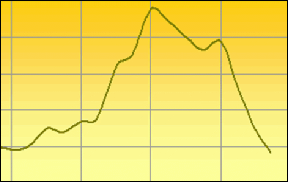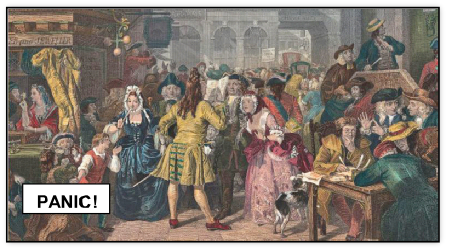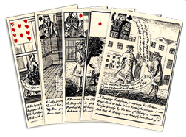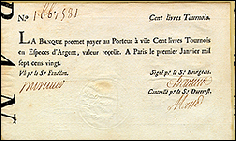


xxxxxThe South Sea Bubble was a serious stock market crash in London following the collapse of The South Sea Company. Having acquired the Asiento de Negros, a monopoly in the slave trade, the price of shares in the company rose substantially, and then increased tenfold when the company took over half the national debt in exchange for trade concessions. There followed a frantic wave of speculation with many people being duped into buying shares of non-
 xxxxxThe South Sea Bubble was a serious stock market crash in London, centred around the fortunes of The South Sea Company. Founded in 1711 by the statesman Robert Harley, Earl of Oxford, this company had acquired the Asiento de Negros, an agreement providing a monopoly of trade -
xxxxxThe South Sea Bubble was a serious stock market crash in London, centred around the fortunes of The South Sea Company. Founded in 1711 by the statesman Robert Harley, Earl of Oxford, this company had acquired the Asiento de Negros, an agreement providing a monopoly of trade -
xxxxxBut in September 1720 the huge bubble burst. The Asiento de Negros, won by Britain at the Treaty of Utrecht, had not proved so favourable as had been expected. Not only had it imposed a hefty annual tax on the traffic in slaves, but normal trade to South America had been restricted to just one boat a year. In reality, there were no vast profits to be made. Seeing the writing on the wall, the chairman, secretary and some of the company's directors sold out and, as a result, stocks plummeted, banks and small companies collapsed, and thousands of investors were ruined. Little more than one third of the original capital was r ecovered for the innocent albeit gullible stockholders.
ecovered for the innocent albeit gullible stockholders.
xxxxxTo make matters worse, the government was thrown into turmoil when a parliamentary investigation disclosed that company officials, including at least three high ranking politicians, had accepted bribes during the affair. Two Whig ministers, Stanhope and Sunderland, died under the strain of the post- his format the South Sea Company survived until 1853.
his format the South Sea Company survived until 1853.
xxxxxIncidentally, in the year of the calamity, a set of South Sea Bubble Playing Cards (“Bubble Cards”) was produced, and this provided an amusing as well as an informative record of the effects of this financial disaster!
THE SOUTH SEA BUBBLE 1720 (G1)
Acknowledgements
Bubble: by the English narrative painter Edward Matthew Ward (1816-
G1-
Including:
The xxxxxx Misissippi
Bubble

xxxxxA similar stock market collapse, the Mississippi Bubble, occurred on the continent at this time. John Law, a Scottish financier living in France, set up a company to develop the Mississippi valley. In 1719, with investment at a high level, he decided to take over the entire trade in French tobacco and slaves. But by then some 625,000 shares had been allocated. To promote confidence, Law then began exchanging shares for Government bonds, but this only fuelled speculation in the stock market, outside as well as inside France. The crash came in 1720, when profits could no longer match investment. Law’s company and bank collapsed, bringing financial ruin to thousands of investors. Law thought it wise to depart for Venice where he died, so we are told, a poor man. In the meantime the French government had to take over the company’s debts and, by increasing taxation, meet part of the loss.
xxxxxBut this shock to the financial system was not confined to Great Britain. Throughout Europe at this time -
 xxxxxThis scheme, which triggered off a frenzy of speculation and ended in financial disaster for many, was the brainchild of John Law (illustrated), a Scottish financier living in France. In 1716, backed by the government, he set up a General Bank to provide low interest loans to private business. Then in 1717 he established the Company of the West with exclusive rights to develop the valley of the Mississippi River, a vast stretch of territory claimed by the French in North America. Two years later -
xxxxxThis scheme, which triggered off a frenzy of speculation and ended in financial disaster for many, was the brainchild of John Law (illustrated), a Scottish financier living in France. In 1716, backed by the government, he set up a General Bank to provide low interest loans to private business. Then in 1717 he established the Company of the West with exclusive rights to develop the valley of the Mississippi River, a vast stretch of territory claimed by the French in North America. Two years later -
 xxxxxProspects for a handsome return on investment looked good, and the company began well, but as public demand for shares rocketed, their value became unrealistic. By 1719 some 625,000 had been issued and Law, attempting to stabilise the position and, at the same time, reduce the huge national debt which had accumulated during Louis XIV's reign, began exchanging company shares for government bonds (illustrated). These securities, clearly regarded as a safe investment, fuelled a massive stock market boom, in other countries as well as in France.
xxxxxProspects for a handsome return on investment looked good, and the company began well, but as public demand for shares rocketed, their value became unrealistic. By 1719 some 625,000 had been issued and Law, attempting to stabilise the position and, at the same time, reduce the huge national debt which had accumulated during Louis XIV's reign, began exchanging company shares for government bonds (illustrated). These securities, clearly regarded as a safe investment, fuelled a massive stock market boom, in other countries as well as in France.
xxxxxAt the same time, the French government, in order to encourage their sale, issued an ever increasing amount of paper money. Unfortunately, however, the company profits could in no way match investment, and in 1720, amid run-


